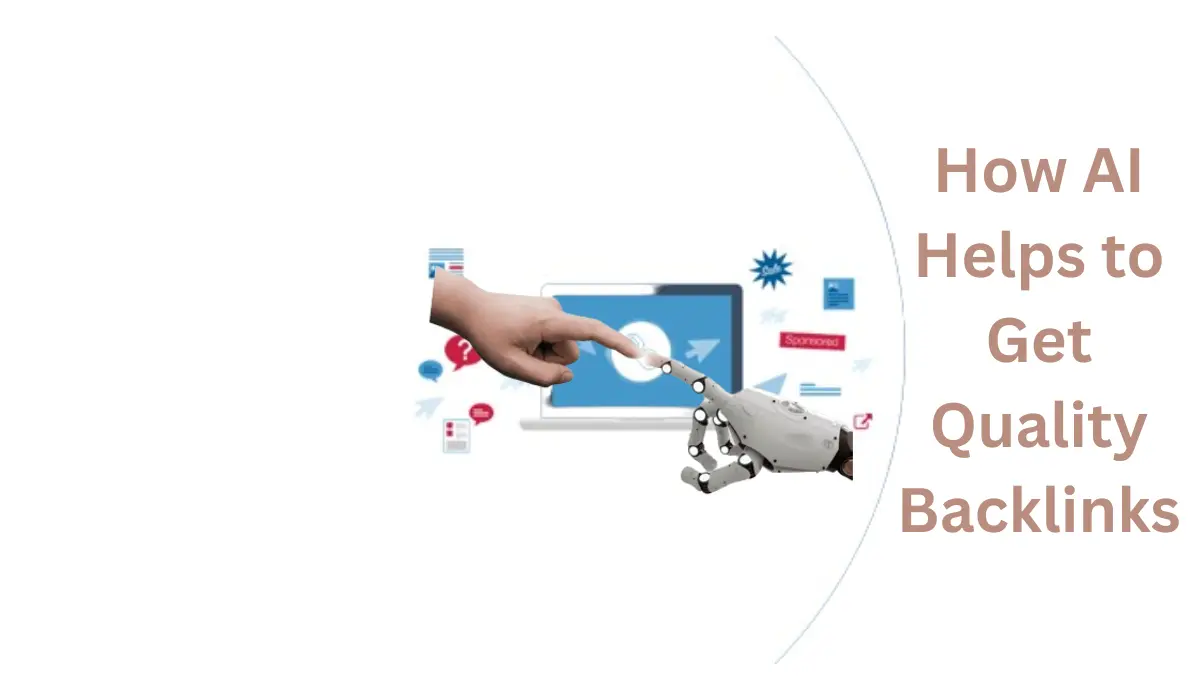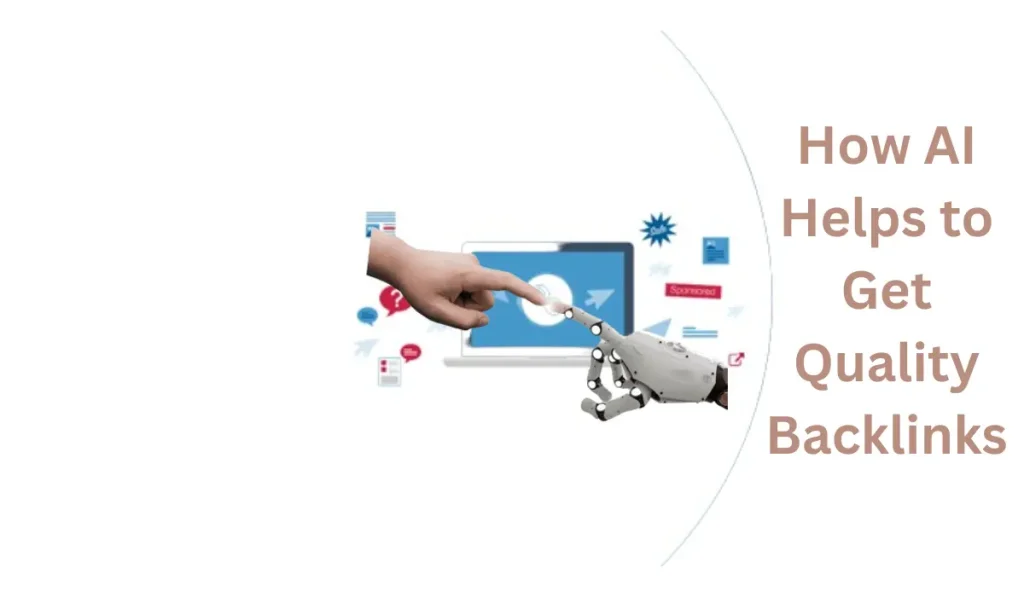Getting quality backlinks is one of the big challenges in off-page SEO work. In today’s high-tech world, AI can help you to get quality and relevant backlinks. In this context, our focus is on how AI helps to get quality backlinks.
Let’s jump into the deep:
Importance of Quality and Relevant Backlinks in SEO
Quality and relevant backlinks are essential components of a successful SEO (Search Engine Optimization) strategy, playing a crucial role in improving website visibility, credibility, and organic search rankings. Here’s why quality and relevant backlinks are important:
Enhanced Search Engine Rankings:
Search engines, such as Google, consider backlinks as votes of confidence from other websites. Quality backlinks from reputable and relevant sources signal to search engines that your website is trustworthy and authoritative in its niche. As a result, your website is more likely to rank higher in search engine results pages (SERPs) for relevant keywords, leading to increased organic traffic and visibility.
Increased Website Credibility:
When your website receives backlinks from authoritative and trustworthy sources, it enhances your website’s credibility and reputation within your industry. Visitors are more likely to perceive your website as a reliable source of information, products, or services, leading to higher trust and engagement.
Targeted Referral Traffic:
Quality backlinks from relevant websites can potentially drive targeted referral traffic to your website. When users click on backlinks from websites that share similar interests or cater to the same audience, they are more likely to be interested in your content or offerings, resulting in higher conversion rates and engagement metrics.
Faster Indexing and Crawling:
Backlinks serve as pathways for search engine crawlers to discover and index new web pages. When your website receives backlinks from authoritative websites, search engines are more likely to crawl and index your content more frequently. This can lead to faster indexing of new content and improved visibility in search results.
Long-Term SEO Benefits:
Quality backlinks provide long-term SEO benefits by establishing a strong foundation for your website’s authority and relevance. Unlike certain SEO tactics that may yield temporary gains, backlinks contribute to sustainable growth and stability in search engine rankings over time.
Competitive Advantage:
In competitive industries and markets, quality backlinks can provide a significant competitive advantage by helping your website stand out from the crowd. By securing backlinks from authoritative websites that your competitors may not have access to, you can strengthen your position in search engine rankings and attract more organic traffic.
Diversified Link Profile:
A diverse portfolio of quality backlinks from various sources, including blogs, news sites, industry directories, and social media platforms, helps to create a robust and natural link profile. Diversification reduces the risk of algorithmic penalties and ensures that your website remains resilient to changes in search engine algorithms.
How AI Helps to Get Quality Backlinks
AI (Artificial Intelligence) plays a significant role in helping to acquire quality backlinks through various innovative approaches and strategies. Here’s how AI contributes to this process:
Content Analysis and Generation:
AI-powered content analysis tools can assess the quality and relevance of existing content on the web. By analyzing trends, keywords, and user engagement metrics, these tools identify potential link-building opportunities. AI can also generate high-quality content that is optimized for search engines, increasing the likelihood of earning backlinks from authoritative websites.
Predictive Analytics:
AI algorithms can analyze vast amounts of data to predict which websites are most likely to link to a particular piece of content. By identifying patterns and correlations in past link-building campaigns, AI can recommend the most effective outreach strategies for acquiring backlinks from relevant and reputable sources.
Natural Language Processing (NLP):
AI-powered NLP technologies enable marketers to understand and analyze the language used in online discussions, forums, and social media platforms. By monitoring conversations and sentiment analysis, AI can identify opportunities to engage with influencers and thought leaders who may be willing to link to your content.
Automated Outreach and Relationship Building:
AI-driven outreach platforms streamline the process of reaching out to potential link partners, saving time and resources for marketers. These platforms can personalize outreach messages based on recipient profiles and engagement history, increasing the likelihood of securing backlinks from high-authority websites.
Automated outreach and relationship building leverage technology and tools to streamline communication and engagement with potential link partners, influencers, and industry peers. This approach enables marketers to scale their outreach efforts while maintaining personalization and relevance. Here’s how automated outreach and relationship building can be implemented effectively:
Identifying Prospects:
Utilize AI-powered tools and software to identify potential link partners, influencers, and relevant websites in your niche. These tools can analyze data such as domain authority, content relevance, and social media engagement to compile a list of prospects that align with your goals.
Personalized Outreach:
Craft personalized outreach messages that resonate with each prospect’s interests, needs, and preferences. Use merge tags and dynamic content to customize emails at scale while ensuring that each message feels authentic and tailored to the recipient.
Automation Tools:
Implement email automation tools that allow you to schedule and send outreach emails in batches, track opens and clicks, and follow up automatically based on predefined triggers. These tools streamline the outreach process, saving time and ensuring consistency in communication.
Follow-Up Sequences:
Set up follow-up sequences to nurture relationships with prospects who haven’t responded to your initial outreach. Automated follow-up emails can be sent at strategic intervals, reminding recipients of your offer or proposal without being overly intrusive.
Social Media Engagement:
Use social media management tools to automate engagement with prospects on platforms such as Twitter, LinkedIn, and Facebook. Schedule posts, share relevant content, and interact with influencers and industry leaders to build relationships and foster connections.
Content Distribution:
Automate the distribution of your content through email newsletters, RSS feeds, and social media channels. By sharing valuable content consistently, you can attract attention, build credibility, and initiate conversations with potential link partners and collaborators.
CRM Integration:
Integrate your outreach efforts with customer relationship management (CRM) software to track interactions, manage contacts, and measure the effectiveness of your campaigns. CRM platforms can provide insights into prospect engagement, allowing you to refine your outreach strategy based on data-driven metrics.
Analytics and Reporting:
Monitor the performance of your outreach campaigns using analytics and reporting tools. Track metrics such as open rates, response rates, and conversion rates to evaluate the success of your efforts and identify areas for improvement.
Link Quality Assessment:
AI algorithms can evaluate the quality and relevance of incoming backlinks by analyzing factors such as domain authority, page rank, and link context. By identifying low-quality or spammy links, AI helps marketers maintain a clean and reputable backlink profile, which is essential for SEO success.
Link quality assessment is the process of evaluating the credibility, relevance, and authority of inbound links pointing to a website. Conducting link quality assessments is essential for maintaining a healthy backlink profile, improving search engine rankings, and avoiding penalties from search engines. Here are some key factors to consider when assessing the quality of backlinks:
Relevance:
Assess the relevance of the linking website to your own website’s content and industry. Links from websites that are closely related to your niche or topic area are generally more valuable in terms of SEO. Relevance helps search engines understand the context of your website and improves the credibility of the backlink.
Authority and Trustworthiness:
Evaluate the authority and trustworthiness of the linking domain using metrics such as domain authority (DA), page authority (PA), and trust flow. Websites with higher authority are more likely to pass valuable link equity to your site, contributing to improved search engine rankings. Look for links from reputable and established websites with a history of producing high-quality content.
Link Placement:
Consider the placement of the backlink within the content of the linking page. Links placed within the main body of the content, surrounded by relevant context, tend to carry more weight than links placed in sidebars, footers, or navigation menus. Additionally, editorially placed links that are voluntarily included by the linking website are generally more valuable than paid or sponsored links.
Anchor Text:
Analyze the anchor text used in the backlink to determine its relevance and naturalness. Natural anchor text should accurately reflect the topic or keywords of the linked page without appearing overly optimized or spammy. Diversify anchor text to include a mix of branded, exact match, and partial match keywords for a more natural link profile.
Link Diversity:
Evaluate the diversity of your backlink profile by analyzing factors such as the number of linking domains, IP addresses, and referring subnets. A diverse link profile with links from a variety of sources indicates organic and natural link acquisition, which is favored by search engines. Avoid excessive reliance on a single source or type of backlink to minimize the risk of penalties.
Link Context:
Examine the context surrounding the backlink, including the relevance and quality of the content on the linking page. Links embedded within high-quality, informative content are more valuable than those placed in low-quality or spammy environments. Ensure that the linking page provides value to users and maintains editorial integrity.
Spam Signals:
Watch out for potential spam signals that could indicate low-quality or manipulative link-building tactics. These may include excessive reciprocal linking, link farms, paid link schemes, and keyword stuffing. Disavow or remove links from spammy sources to protect your website’s credibility and avoid penalties from search engines.
Competitive Analysis:
AI-powered competitive analysis tools can identify the backlink strategies employed by competitors, allowing marketers to benchmark their performance and identify gaps and opportunities. By studying competitor backlink profiles, marketers can uncover potential link-building opportunities and devise strategies to outperform competitors in search engine rankings.
Also Read
Dynamic Link Building Strategies:
AI enables marketers to adapt and refine their link-building strategies in real time based on changing market dynamics and search engine algorithms. By continuously analyzing data and performance metrics, AI helps marketers optimize their efforts and maximize the impact of their link-building campaigns.
Dynamic link-building strategies involve adapting and adjusting your link-building tactics based on evolving trends, algorithm changes, and the competitive landscape. These strategies prioritize flexibility, creativity, and responsiveness to achieve sustainable results in SEO. Here are some dynamic link-building strategies:
Content Gap Analysis:
Conduct a comprehensive analysis of your competitors’ content and backlink profiles to identify gaps and opportunities. Look for topics and keywords that your competitors are ranking for but that you haven’t covered extensively on your website. Create high-quality, informative content targeting these gaps to attract backlinks from relevant sources.
Trend Monitoring and Capitalization:
Stay abreast of industry trends, current events, and seasonal topics that resonate with your target audience. Create timely and relevant content that addresses trending topics and capitalize on opportunities to earn backlinks from news sites, blogs, and social media platforms. Monitor trending hashtags, news alerts, and social media discussions to identify link-building opportunities.
Resource Link Building:
Develop comprehensive resource pages, guides, and directories that provide valuable information and resources to your target audience. Outreach to relevant websites, bloggers, and influencers in your niche to promote your resource pages and encourage them to link to them as authoritative references. Resource link building fosters natural backlink acquisition and positions your website as a valuable resource within your industry.
Expert Roundups and Interviews:
Collaborate with industry experts, influencers, and thought leaders to create expert roundups, interviews, and Q&A sessions. Feature their insights, opinions, and advice on relevant topics, and then outreach to participants and their networks to share the content. Expert contributions often lead to natural backlinks from participants’ websites and social media profiles, enhancing your website’s authority and credibility.
Community Engagement and Outreach:
Engage with online communities, forums, and discussion groups related to your industry or niche. Provide helpful answers to questions, share valuable insights, and participate in discussions without overtly promoting your website. Establishing genuine relationships with community members can lead to organic backlinks as others recognize your expertise and value your contributions.
Visual and Interactive Content:
Create visually engaging and interactive content such as infographics, videos, quizzes, and interactive tools that are highly shareable and link-worthy. Outreach to bloggers, journalists, and influencers in your niche to promote visual content and encourage them to embed or link to it in their articles and posts. Visual and interactive content tends to attract more attention and backlinks than traditional text-based content.
Partnerships and Collaborations:
Forge strategic partnerships and collaborations with complementary brands, influencers, and organizations in your industry. Co-create content, host joint webinars or events or cross-promote each other’s offerings to leverage each other’s audiences and networks. Collaborative efforts often result in mutual backlinking and increased visibility for both parties.
Monitoring and Adjusting:
Continuously monitor the performance of your link-building efforts using analytics and reporting tools. Track metrics such as referral traffic, backlink growth, and keyword rankings to assess the effectiveness of your strategies. Adjust your tactics based on data-driven insights and feedback to optimize your link-building campaigns over time.
End Words
Overall, AI empowers marketers to leverage data-driven insights and automation to acquire high-quality backlinks more efficiently and effectively. By combining human creativity with AI-driven analytics and automation, marketers can unlock new opportunities for organic growth and success in the competitive landscape of online marketing.







